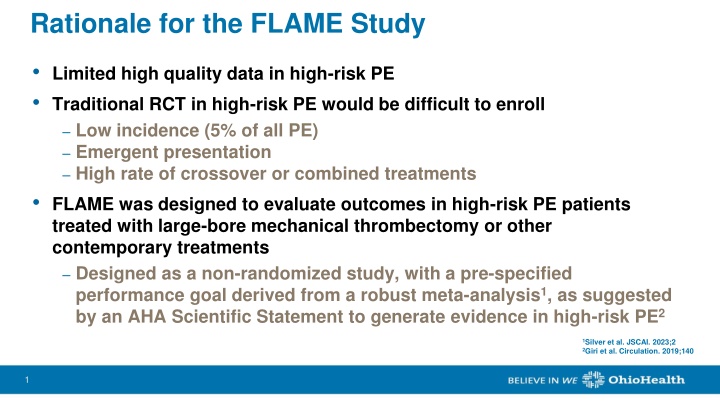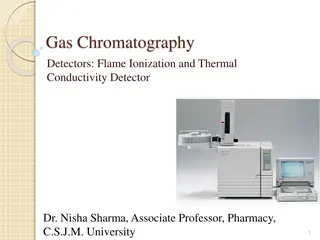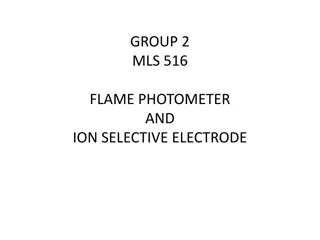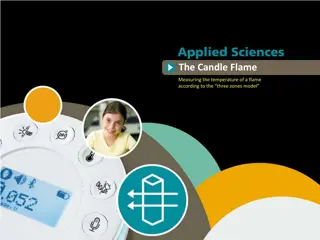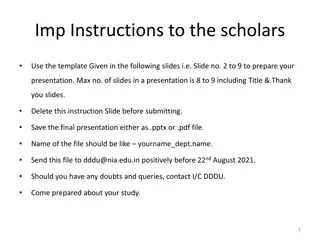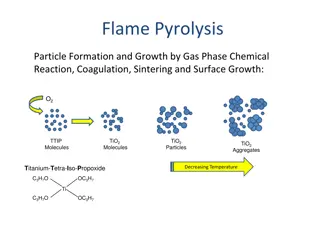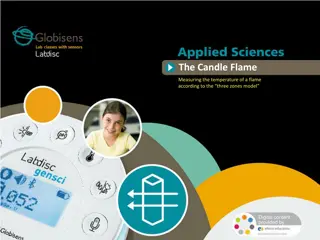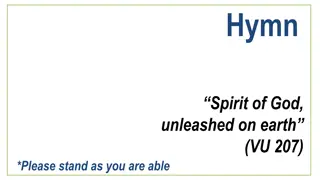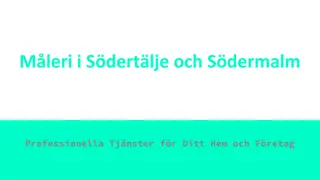Rationale for the FLAME Study
The FLAME study was designed to assess outcomes in high-risk pulmonary embolism (PE) patients using large-bore mechanical thrombectomy and contemporary treatments. This prospective, multicenter, non-randomized study focused on in-hospital composite endpoints including mortality, thrombus removal, clinical deterioration, and bleeding. The study was halted early after meeting the interim analysis criterion, demonstrating the importance of innovative research approaches in challenging clinical scenarios.
Download Presentation

Please find below an Image/Link to download the presentation.
The content on the website is provided AS IS for your information and personal use only. It may not be sold, licensed, or shared on other websites without obtaining consent from the author.If you encounter any issues during the download, it is possible that the publisher has removed the file from their server.
You are allowed to download the files provided on this website for personal or commercial use, subject to the condition that they are used lawfully. All files are the property of their respective owners.
The content on the website is provided AS IS for your information and personal use only. It may not be sold, licensed, or shared on other websites without obtaining consent from the author.
E N D
Presentation Transcript
Rationale for the FLAME Study Limited high quality data in high-risk PE Traditional RCT in high-risk PE would be difficult to enroll Low incidence (5% of all PE) Emergent presentation High rate of crossover or combined treatments FLAME was designed to evaluate outcomes in high-risk PE patients treated with large-bore mechanical thrombectomy or other contemporary treatments Designed as a non-randomized study, with a pre-specified performance goal derived from a robust meta-analysis1, as suggested by an AHA Scientific Statement to generate evidence in high-risk PE2 1Silver et al. JSCAI. 2023;2 2Giri et al. Circulation. 2019;140 1 1
FLAME: Trial Design Prospective, multicenter, non-randomized, parallel group, observational study of high-risk PE Trial Details High-risk PE Patients Specific treatment not dictated (physician discretion) Concurrent, non-randomized enrollment Patients followed through discharge or 45 days Designed to capture all high-risk PE patients: Waiver of consent for unbiased enrollment Chart review to ensure no high- risk patients were missed Prior Therapy Arm* Context Arm FlowTriever Arm Lower-risk PE treated with advanced therapy but progressed to high- risk PE Other non-FlowTriever therapies as primary treatment FlowTriever mechanical thrombectomy as primary treatment *Not shown due to low enrollment (n=1) 2 2
FLAME: Eligibility Criteria Inclusion Criteria Exclusion Criteria Out of hospital cardiac arrest with Glasgow Coma Scale 8 Cardiac arrest with ongoing CPR >30 minutes Contraindication to anticoagulants, i.e. heparin or alternative Hematocrit <28% Platelets <25,000/ L INR >8 Intracardiac thrombus or clot in transit Anaphylactic sensitivity to radiographic agents History of pulmonary hypertension with systolic PA pressure >70 mmHg Chronic medical conditions with <90 days of life expectancy COVID-19 positive 18 years of age Presenting with high-risk PE PE determined to be cause of shock One or more of the following: Systolic BP <90 mmHg or drop of >40 mmHg for at least 15 minutes Need for vasopressor support Resuscitation after cardiac arrest with <30 minutes of CPR and Glasgow Coma Scale >8 3 3
FLAME: Endpoints Primary Endpoint Analysis Primary Endpoint* In-hospital composite: All-cause mortality Bailout to alternate thrombus removal strategy Clinical deterioration Major bleeding The FlowTriever Arm primary endpoint was compared to a performance goal of 32% which was established from our published meta-analysis A pre-specified interim analysis was planned at 50 FlowTriever patients enrolled Secondary Endpoints FLAME was stopped early after meeting the pre-specified interim analysis criterion at 50 FlowTriever patients Safety*: Primary endpoint components, stroke, device- related complications, and access site injury Utility measures: Hospital and ICU stay, ECMO use, time to extubation, and discharge location *CEC-adjudicated for FlowTriever and Context Arms (BCRI) Derived from a meta-analysis of high-risk PE outcomes; Silver et al. JSCAI. 2023;2 4 4
Baseline Characteristics and History 115 patients from 11 US sites* FlowTriever Arm (n = 53) Context Arm (n = 61) Age, years 64.8 15.3 61.6 13.9 Female 26/53 (49.1%) 35/61 (57.4%) BMI, kg/m2 32.2 6.1 33.9 8.5 History Systemic HTN 37/51 (72.5%) 41/61 (67.2%) Pulmonary HTN 4/48 (8.3%) 2/59 (3.4%) PE 7/53 (13.2%) 7/60 (11.7%) DVT 16/52 (30.8%) 12/60 (20.0%) Cancer 12/53 (22.6%) 13/59 (22.0%) Active Cancer 7/52 (13.5%) 5/59 (8.5%) Contraindication to thrombolytics 22/53 (41.5%) 7/60 (11.7%) Absolute 6/53 (11.3%) 3/60 (5.0%) Relative 16/53 (30.2%) 4/60 (6.7%) *Prior Therapy Arm not shown due to low enrollment (n=1) 5 5
Clinical Presentation Context Arm (n = 61) FlowTriever Arm (n = 53) Reason for high-risk PE: Systolic BP <90 mmHg or decrease of >40 mmHg for 15 minutes Need for vasopressor support Resuscitation after cardiac arrest with <30 minutes of CPR and Glasgow Coma Scale >8 31 (50.8%) 46 (75.4%) 20 (32.8%) 34 (64.2%) 32 (60.4%) 11 (20.8%) SCAI shock stage A B C D E 2 (3.8%) 11 (20.8%) 29 (54.7%) 5 (9.4%) 6 (11.3%) 1 (1.6%) 6 (9.8%) 22 (36.1%) 12 (19.7%) 20 (32.8%) PE Location Central Lobar Segmental 49 (92.5%) 36 (67.9%) 27 (50.9%) 40/53 (75.5%) 36/53 (67.9%) 25/53 (47.2%) 6 6
Primary Treatment Details FlowTriever Arm (n = 53) Context Arm (n = 61) Primary Treatment: Primary Treatment: FlowTriever 53 (100%) Systemic thrombolytics 42 (68.9%) Anticoagulation alone 14 (23.0%) 100 [20-240], n = 46 Estimated blood loss, mL Catheter-directed thrombolytics 4 (6.6%) Surgical thrombectomy 1 (1.6%) 50 [0-200], n = 10 With FlowSaver, mL Mechanical thrombectomy 0 (0%) 7 7
Primary Endpoint Composite Primary Endpoint: 17.0%* FlowTriever Arm *Significantly lower than the performance goal of 32.0% (P<0.01) Composite Primary Endpoint: 63.9% Context Arm 8 8
Primary Endpoint Components In-hospital mortality 40% 30% 29.5% 28.5% 20% 10% 1.9% 0% FlowTriever Arm Performance Goal Literature-based Context Arm n = 53 n = 61 9 9
Primary Endpoint Components Bailout Clinical deterioration Major bleeding 40% 40% 40% 30% 30% 30% 30.3% 26.2% 24.6% 20% 20% 20% 21.3% 15.6% 15.1% 10% 10% 10% 11.5% 11.3% 3.8% 0% 0% 0% FlowTriever Arm Performance Goal Literature-based Context Arm n = 53 n = 61 10 10
Safety Outcomes FlowTriever Arm (n = 53) Context Arm (n = 61) Stroke Ischemic Hemorrhagic 1 (1.9%) 1 0 4 (6.6%) 2 2* Subjects with device-related complication Most common: Hemoglobin decrease or anemia Vascular access site hemorrhage/hematoma Hypotension 12 (22.6%) 10 (16.4%) 8 4 1 3 4 3 FlowTriever Arm: No reports of device-related tricuspid valve injuries, cardiac injuries, or pulmonary vascular injuries Context Arm: *ICH in 2/42 (4.8%) patients who received systemic thrombolytics 11 11
Safety Outcomes FlowTriever Arm (n = 53) Context Arm (n = 61) Subjects with SAEs 16 (30.2%) 37 (60.7%) Subjects with SAEs related to primary treatment device or therapy 10 (18.9%) 23 (37.7%) 17 (27.9%) Related to thrombolytic therapy 0 (0%) 1 (4.3%) Related to ECMO only 0 (0%) Subjects with access site injury requiring intervention 5 (8.2%) 4 (7.5%) 12 12
Secondary Endpoints Discharge Location 100% Home Home with home healthcare 80% Context Arm Utility Measures FlowTriever Arm Care facility or skilled nursing home Not discharged 8.0 [6.0-15.0] n = 43 Length of stay post- treatment, nights* 7.0 [3.0-12.5] n = 52 60% Length of ICU stay post-treatment, nights* 3.0 [1.0-7.0] n = 43 2.0 [1.0-4.0] n = 52 40% Other 7/61 (11.5%) ECMO use 3/53 (5.7%) 1.8 [1.5-3.1] n = 6 20% Time to extubation, days 1.6 [1.2-4.3] n = 4 0% *In surviving patients In surviving patients who underwent a single intubation procedure prior to primary treatment and were extubated prior to study exit FlowTriever Arm n = 53 Context Arm n = 61 13 13
Conclusion The FLAME study is the largest interventional trial in high-risk PE Large-bore mechanical thrombectomy with FlowTriever was associated with a significantly lower occurrence of meaningful in- hospital adverse clinical outcomes In-hospital mortality, bailout, clinical deterioration, major bleeding FlowTriever was associated with remarkably low mortality FlowTriever Arm: 1.9% Performance goal: 28.5% Context Arm: 29.5% 14 14
Limitations Not a randomized controlled trial Despite efforts, cannot guarantee capture of all high-risk PE patients Treatment type was at the discretion of treating physician, which may have introduced selection bias Follow-up limited through discharge, however the highest risk of mortality in high-risk PE is during the index hospitalization 15 15
Implications Large-bore mechanical thrombectomy with the FlowTriever System likely reduces mortality in high-risk PE patients by rapidly unloading the RV Quickly reverses the obstructive shock death spiral Simultaneously improves oxygenation A care pathway similar to STEMI and stroke may benefit high-risk PE patients Teams are accustomed to treating critically ill patients with access to hemodynamic assessment and advanced support therapies 16 16
Acknowledgments Principal Investigators Sites/Affiliations Mitch Silver (National co-PI) OhioHealth Heart and Vascular, Columbus, OH Jim Horowitz (National co-PI) NYU Grossman School of Medicine, New York, NY Sameer Khandhar Perelman School of Medicine at University of Pennsylvania, Philadelphia, PA Jay Giri Perelman School of Medicine at University of Pennsylvania, Philadelphia, PA Wissam Jaber Emory University Hospital, Atlanta, GA Herman Kado Ascension Providence Hospital, Southfield, MI Catalin Toma University of Pittsburgh Medical Center, Pittsburgh, PA David Zlotnick University at Buffalo, Gates Vascular Institute, Buffalo, NY Terry Bowers Corewell Health William Beaumont University Hospital, Royal Oak, MI Paul Butros Inova Health Systems Heart and Vascular Institute, Fairfax, VA Aaron DuCoffe Inova Health Systems Heart and Vascular Institute, Fairfax, VA Lee Greenspon Lankenau Medical Center, Wynnewood, PA Bushra Mina Lenox Hill Hospital, Northwell Health, New York, NY Mithun Chakravarthy AHN Cardiovascular Institute at Allegheny General Hospital, Pittsburgh, PA 17 17
Take Home Points From the FLAME Trial A modern day peer reviewed meta analysis of high-risk PE literature provided the performance goal as a point of reference. All end points were adjudicated by an independent CEC. All patients met the modern day definition of high-risk or massive PE. The context arm provided context and helped capture all high-risk PE patients in the study to assess outcomes. There was no randomization. 18 18
Take Home Points From the FLAME Trial The FlowTriever group had a mortality of 1.9% and 17 % of patients reached the composite primary endpoint. The context arm had a mortality of 29.5 % and 63.9 % reached the composite primary endpoint. All patients with SCAI shock D/E treated with FlowTriever survived. 46 % of patients with SCAI shock D/E in the context arm died. 19 19
Waiver of Informed Consent >> Confusion The FLAME protocol was approved by all institutional IRBs. ALL PATIENTS consented for any procedure by hospital protocol. The waiver of informed consent was to participate in the registry only. FDA guidelines were followed for waiver of informed consent: No IC needed for an observational registry Data all de-identified Physician treatment/management was not prescribed or dictated The AHA scientific statement published in 2019 was followed exactly as recommended .. 20 20
Perspective Treatment type was at the discretion of the treating physician : Experienced PE centers and physicians were chosen by design. Was the patient stable enough to reach the cath lab ? Was an experienced operator available or even consulted ? More patients with advanced shock presented on nights/weekends. Was the clot anatomy suitable for FT ? Our conclusion is NOT that FT treated patients did better than context arm patients (not randomized by design). But that massive PE patients that can be taken to the cath lab treated with FT have very good results. 21 21
THANK YOU 22 22
